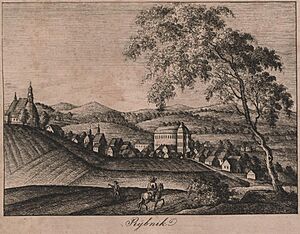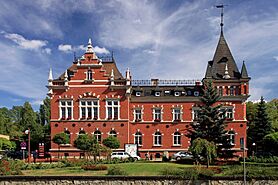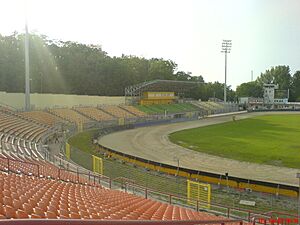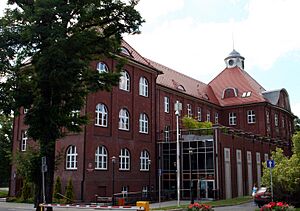Rybnik facts for kids
Quick facts for kids
Rybnik
|
|||
|---|---|---|---|

Main Square
|
|||
|
|||
| Country | |||
| Voivodeship | Silesian | ||
| County | city county | ||
| Established | 10th century | ||
| Town rights | before 1308 | ||
| Area | |||
| • City | 148 km2 (57 sq mi) | ||
| Highest elevation | 290 m (950 ft) | ||
| Lowest elevation | 210 m (690 ft) | ||
| Population
(31 December 2021)
|
|||
| • City | 135,994 |
||
| • Density | 930/km2 (2,400/sq mi) | ||
| • Metro | 527 017 | ||
| Time zone | UTC+1 (CET) | ||
| • Summer (DST) | UTC+2 (CEST) | ||
| Postal code |
44-200 to 44-292
|
||
| Area code(s) | +48 32 | ||
| Car plates | SR, IR | ||
Rybnik is a city in southern Poland. It's located in the Silesian Voivodeship, about 38 km (24 mi) southwest of Katowice. Katowice is the capital city of this region. Rybnik is also close to the Czech border, about 19 km (11 mi) away.
Rybnik is a big city in the Katowice-Ostrava metropolitan area. This area has about 5.3 million people. Rybnik is also the main city of the "Subregion Zachodni," which used to be called the Rybnik Coal Area. As of January 1, 2022, Rybnik has 135,994 people. This makes it the 25th most populated city in Poland.
The city is a hub for business, shopping, and culture in its part of the Silesian Voivodeship. It's known for its music scene. Famous musicians like Henryk Górecki and Lidia Grychtołówna studied at the Szafrankowie School of Music here. Rybnik also has its own Philharmonic Orchestra.
The name Rybnik comes from an old Slavic word meaning "pond." A pond used to be where the main market square is today. In the Middle Ages, three small settlements joined together to form the town. Rybnik officially became a town before 1308. Fishing, trade, and crafts were important jobs back then. The city grew a lot in the late 1800s when rich coal fields were found. Since the 1990s, Rybnik has been growing its economy in other ways, like business and healthcare.
Contents
History of Rybnik
The name Rybnik comes from the word for "fish" (ryba) in old Polish. It meant "fishpond." This shows how important fish farming was to the city's economy long ago. You can still see this in the city's coat of arms today.
Early Beginnings and Town Rights
Rybnik's story began around the 9th and 10th centuries. Three Slavic villages existed where Rybnik is now. These villages eventually joined to form one town. In the 10th century, it became part of the new Polish state under its first ruler, Mieszko I.
Around 1308, Rybnik was granted city rights under a system called Magdeburg Law. This helped the town grow. Even with these new rights, Rybnik remained part of the Kingdom of Poland. Later, in 1327, most of Silesia became linked to the Bohemian Crown. However, Rybnik was still led by local Polish dukes from the Piast dynasty until 1336.
Growth and Changing Rulers
Rybnik continued to grow and became an important trade center in the region. In the 15th century, the Hussites caused damage to the city. They were later defeated in a battle nearby in 1433. Over the years, Rybnik was ruled by different kingdoms. It was under Hungarian rule around 1469, then returned to Bohemia in 1490.
From 1521, Polish Piast dukes ruled Rybnik again. It was part of the Duchy of Opole and Racibórz. In 1532, it became part of Bohemia, which was then under the Habsburg family. Rybnik became the capital of a special area ruled by noble families. One of these was the Polish Węgierski family, who ruled from 1682 until 1788.
Prussian Rule and Coal Mining
In 1740, during the War of the Austrian Succession, most of Silesia, including Rybnik, was taken over by Prussia. Austria officially recognized this in 1763. Coal mining became very important for Rybnik's economy in the 18th century. In 1871, Prussia, with Rybnik, became part of the German Empire. At this time, Poland was no longer an independent country. It had been divided among Prussia, Austria, and Russia in 1795.
Return to Poland and World War II
In the late 1800s and early 1900s, there were growing tensions in the Upper Silesia region. After World War I ended in 1918, Poland became an independent state again. There were local uprisings, known as the Silesian Uprisings, with the first one in 1919 centered in Rybnik. In 1921, people voted to decide if the area should be part of Germany or Poland. While the city of Rybnik voted mostly for Germany, the larger Rybnik district voted for Poland. So, Rybnik became part of Poland for the first time since 1788.
Between the two World Wars, Rybnik was part of the Silesian Voivodeship in Poland. It had a lot of freedom in how it was run. In 1933, the famous Polish musicians Karol and Antoni Szafranek started a music school here.
When World War II began in September 1939, Germany took over Rybnik. During the German occupation, the city was directly added to Germany. Many local teachers and school leaders were among those who suffered greatly. A forced labor camp for Poles was also operated in the city from 1942 to 1945. This camp mainly held children whose parents were arrested or sent away, as well as elderly people. Despite this, the Polish resistance movement was active in Rybnik. In January 1945, during the final stages of the war, German forces caused the deaths of 385 prisoners from the Auschwitz concentration camp in the city during a forced march.
Post-War Development
After Germany's defeat in 1945, Rybnik became part of Poland again. The city was no longer on the German-Polish border. Many Germans from Rybnik later moved to the German city of Dorsten. Dorsten became one of Rybnik's twin towns in 1994.
After the war, coal mining continued to be very important. Under Poland's communist government (1945–1989), Rybnik was planned to grow as a major mining center. In the 1970s, a large coal-fired power plant was built. A reservoir on the Ruda river was created to cool the power plant. In 2002, several universities from Katowice and Gliwice opened a joint campus in Rybnik. This helped improve education in the area.
Population of Rybnik
Historically, Rybnik was a small town. Its population only went over 1,000 people in the late 1700s. It was similar in size to nearby towns like Żory. The population grew faster after Prussia took over Silesia in 1740.
Growth and Changes in Population
In 1818, Rybnik became a county seat. In 1856, a railway connected Rybnik with Racibórz. Two years later, in 1858, Rybnik got a rail connection to Katowice. These connections helped the city grow even faster. While coal discoveries in the late 1800s led to growth in nearby villages, Rybnik remained more of a market town.
After World War II, the Polish communist government focused on heavy industry. They increased coal production around Rybnik. They also built a new city for miners nearby. Because of its central location, Rybnik became the main city of the Rybnik Coal Area. Its population grew to 44,400 people by 1972.
In the 1970s, Rybnik added many nearby mining towns and villages. This caused its population to jump to 118,200 by the end of the decade. Many new workers moved to Rybnik from other parts of Poland. This was because there weren't enough local workers. By the 1970s and 80s, about 30% of people in Rybnik were new migrants. Rybnik's population kept growing until it reached its highest point in 1997 with 144,943 people.
Current Population Information
On January 1, 2021, Rybnik had 137,128 residents. The city has about 955 people per square kilometer.
In 2020, the age groups were:
- 25,166 people (18.4%) were under 18.
- 50,183 people (36.6%) were aged 18–44.
- 31,248 people (22.8%) were aged 45–64.
- 30,531 people (22.3%) were 65 and older.
The birth rate in Rybnik in 2020 was 1.39. This is below the level needed for the population to stay the same (2.1). However, it is slightly above Poland's average of 1.38.
As of the 2011 census, here's the education breakdown for people 15 and older:
- 17,919 people (15.8%) had a college degree.
- 35,709 people (31.6%) had a high school diploma.
- 36,249 people (32%) had a vocational school diploma.
- 21,265 people (20.6%) did not have a high school or vocational school diploma.
Nationality, Language, and Religion
The 2011 census showed that 85.2% of Rybnik citizens said they were Polish. People could choose up to two nationalities. Silesians were the largest group other than Polish, making up 28.6% (40,311 people). Germans were 0.5% (707 people).
Polish was the most common language spoken at home (94.5%). About 24,372 people (17.3%) said they speak Silesian at home. Since 2011, many immigrants have come to Poland, especially from Ukraine. Rybnik city hall estimates that about 10,000 Ukrainian immigrants live in the city as of 2021.
Catholicism was the largest religion in Rybnik in 2011. There were 127,809 Catholics (90.69% of all residents). The only other group with more than 300 followers was Jehovah's Witnesses, with 434 people (0.31%). About 2,270 people (1.61%) said they had no religion. Other religions with places of worship in Rybnik include Buddhists, Seventh Day Adventists, Lutherans, and Pentecostals.
Neighborhoods of Rybnik
Rybnik is divided into 27 neighborhoods. These are like smaller administrative areas. Most of them are suburban areas. Some examples include:
- Chwałęcice
- Golejów
- Gotartowice
- Grabownia
- Kamień
- Kłokocin
- Ligota-Ligocka Kuźnia
- Meksyk
- Ochojec
- Orzepowice
- Popielów
- Radziejów
- Rybnicka Kuźnia
- Rybnik – Północ
- Stodoły
- Wielopole
- Zamysłów
- Zebrzydowice
Four former towns have also joined Rybnik:
- Boguszowice Stare
- Chwałowice
- Niedobczyce
- Niewiadom
Two districts, Boguszowice Osiedle and Maroko-Nowiny, are typical Polish housing estates. They have large apartment buildings and places like shops and schools built during the communist era. The remaining three districts are:
- Smolna
- Śródmieście
- Paruszowiec-Piaski
These three areas made up the old town of Rybnik before the war. Śródmieście (which means "city center") has the old town, city hall, most schools, offices, and shopping malls. Paruszowiec has 19th-century factories and houses.
Things to See and Do in Rybnik
Rybnik is known as a "green" city. It has a cleaner environment compared to the industrial areas nearby. While it's not a huge tourist spot, it offers many interesting places and fun activities.
Outdoor Activities
To the northeast of the city, there's a reservoir called Zalew Rybnicki on the Ruda river. This reservoir helps cool the power station. It's surrounded by forests and is a great place for:
- Swimming
- Fishing
- Sailing
- Surfing
Because of the warm water from the power station, the reservoir stays warm all year. This makes it a home for fish like grass carps. The Beskidy Mountains, a popular area for recreation and skiing, are also just a 1–2 hour drive away.
Historic Sights to Visit
Here are some interesting places to see in Rybnik:
- The neo-gothic basilica of St. Anthony (Bazylika św. Antoniego).
- The building of the former district authority, built in 1887.
- The neo-classical new town hall, built in 1928.
- The neo-classical old town hall with a clock-tower. It now holds the registry office and the local history museum.
- The Church of St. Catherine (Kościół św. Katarzyny), built in 1534.
- The Church of St. Lawrence (Kościół św. Wawrzyńca), built in 1717.
- A late Baroque estate house from 1736.
- A Piast castle from the early 13th century. It was completely changed in the 18th century.
Sports in Rybnik
Rybnik is a place where sports thrive! In 2006, the 8th European Glider Aerobatic Championships were held here.
The aeroclub of Rybnik is very successful in glider aerobatic competitions. These are competitions where pilots perform amazing tricks in the air with gliders.
- Jerzy Makula from Rybnik has won the European Glider Aerobatic Championships twice. He has also won the World Glider Aerobatic Championships six times!
- Other talented members from the aeroclub who have been part of the Polish national glider aerobatics team include Małgorzata Margańska, Krzysztof Brzikalik, Lucjan Fizia, Stanisław Makula, and Ireneusz Boczkowski.
Local Sports Teams
Rybnik has several sports teams:
- ROW Rybnik – This is a club with many different sports teams.
- Thunders Rybnik – This is an american football team.
Climate in Rybnik
Rybnik has a humid continental climate. This means it has warm summers and cold winters.
Notable People from Rybnik
Many interesting people have come from Rybnik:
- Otto Landsberg (1869–1957), a German politician.
- Hermann Boehm (1884–1972), a German Admiral.
- Lidia Grychtołówna (born 1928), a famous pianist.
- Henryk Górecki (1933–2010), a well-known composer of classical music.
- Adam Makowicz (born 1940), a jazz pianist.
- Piotr Paleczny (born 1946), another talented pianist.
- Olek Krupa (born 1947), an actor.
- Tomasz Zdebel (born 1973), a Polish-German footballer.
- Jerzy Dudek (born 1973), a famous footballer.
- Thomas Godoj (born 1978), a Polish-German singer who won a popular TV show in 2008.
- Krzysztof Bodziony (born 1985), a footballer.
- Ewa Sonnet (born 1985), a model and singer.
Twin Towns – Sister Cities
Rybnik has "twin towns" or "sister cities" around the world. These are cities that have special friendly relationships with each other.
 Antrim and Newtownabbey, Northern Ireland, United Kingdom (2003)
Antrim and Newtownabbey, Northern Ireland, United Kingdom (2003) Bar, Ukraine (2007)
Bar, Ukraine (2007) Dorsten, Germany (1994)
Dorsten, Germany (1994) Eurasburg, Germany (2001)
Eurasburg, Germany (2001) Ivano-Frankivsk, Ukraine (2001)
Ivano-Frankivsk, Ukraine (2001) Karviná, Czech Republic (2004)
Karviná, Czech Republic (2004) Labin, Croatia (2019)
Labin, Croatia (2019) Larissa, Greece (2003)
Larissa, Greece (2003) Liévin, France (2000)
Liévin, France (2000) Mazamet, France (1993)
Mazamet, France (1993) Saint-Vallier, France (1961)
Saint-Vallier, France (1961) Topoľčany, Slovakia (2008)
Topoľčany, Slovakia (2008) Vilnius District Municipality, Lithuania (2000)
Vilnius District Municipality, Lithuania (2000)
Images for kids
See also
 In Spanish: Rybnik para niños
In Spanish: Rybnik para niños














